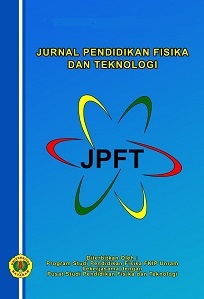Penerapan Advance Organizer Dengan Model Pembelajaran Ekspositori Berpola Lesson Study Untuk Meningkatkan Hasil Belajar Fisika Peserta Didik
DOI:
10.29303/jpft.v4i1.736Issue:
Vol. 4 No. 1 (2018): Januari - Juni 2018Keywords:
advance organizer, expository learning, lesson studyArticles
Downloads
How to Cite
Downloads
Metrics
Abstract
This study aims to improve the quality of learning through the implementation of lesson study (LS) with expository learning model assisted advance organizer to improve activity and learning outcomes. Implementation of LS is done in SMA Negeri 3 Mataram by taking X class MIA3 and considered appropriate. LS is executed in two action cycles with stages plan, do (implementation and observation), and see (reflection). The research data are qualitative and quantitative data. Qualitative data are derived from important notes of planning and implementation phases and instructional sheet of instructional learning, student activity, and teacher activity, as well as the reflection stage. Quantitative data are analyzed to see improvements in learning outcomes. Implementation of lesson study through expository model assisted by advace organizer can improve physics learning result of class X student of MIA3 SMAN 3 Mataram. The average score of student activity increases from 22.17 with active category in cycle I to 28.85 with very active category in cycle II. Increased classical completeness achievement 70% cycle I to 91% in cycle II.References
Amanah, P. D., Harjono, A & Gunada, I. W. 2017. Kemampuan Pemecahan Masalah Dalam Fisika Dengan Pembelajaran Generatif Berbantuan Scaffolding dan Advance Organizer. Jurnal Pendidikan Fisika dan Teknologi. 3(1), 84-91.
Arends, R. I. 2007. Learning to Teach. New York: McGraw Hill Company, Inc.
Ausubel, D.P. 1960. The Use of Advance Organizers in the Learning and Retention of Meaningful Verbal Material. Journal of Educational Psychology. 51.
Ausubel, D.P. 1963. Cognitive Structure and the Facilitation of Meaningful Verbal Learning. Journal of Teacher Education, 14.
Ausubel, D.P. 1978. The defense of Advance Organizers: A reply to the Critics. Review of Educational Research. 48(2): 251-257.
Diptoadi, V.L. 1990. Pengaruh Cara Penyampaian Bacaan dengan Menggunakan Advance Organizer dan Daftar Kata Pokok Terhadap Perolehan Membaca Mahasiswa Jurusan Bahasa Inggris yang Memiliki Karakter Berbeda. Desertasi tidak diterbitkan. Malang: Program Pascasarjana IKIP Malang.
Downing, A. 1994. An Investigation of the Advance Organizer Theory as an Effective Teaching Model. Paper presented at the Annual Meeting of Australian Teacher Education Association (24th), Queensland Australia. July 3-6.
Hamdanillah, N, Harjono, A, & Susilawati, S. 2017. Pengaruh Model Pembelajaran Advance Organizer Menggunakan Video Pembelajaran Terhadap Hasil Belajar Fisika Peserta Didik Kelas XI, Jurnal Pendidikan Fisika dan Teknologi. 3(2), 120-127.
Harjono, A. 2011. Perbedaan Strategi Pembelajaran dan Pemberian Advance Organizer Pengaruhnya Terhadap Hasil Belajar Fisika Siswa Kelas X. Jurnal Pijar Matematika Ilmu Pengetahuan Alam. 7(1), 13-17.
Hasbiyalloh, A. S., Harjono, A, & Verawati, N.N.S.P. 2017. Pengaruh Model Pembelajaran Ekspositori Berbantuan Scaffolding dan Advance Organizer Terhadap Hasil Belajar Fisika Peserta Didik Kelas X. Jurnal Pendidikan Fisika dan Teknologi. 3(2), 173-180.
Heinich, R., Molenda, M., Russell, D.J. & Smaldino, E. 2002. Instructional Media and Technology for Learning. (Seventh edition). New Jersey: Prentice Hall, Inc.
Huda, M. 2013. Model-Model Pengajaran dan Pembelajaran. Yogyakarta: Pustaka Pelajar.
Hunter, M. 1984. Instructional Theory into Practice. Virginia: Polytechnics Institute.
Jacobsen, D., Eggen, P. & Kauchack, D. 1989. Methods for Teaching: A Skill Approach. Colombus, Ohio: Merrill Publishing Company.
Joyce, B., Weil, M. & Calhoun, E. 2000. Models of Teaching. (6thed). NJ: Allyn & Bacon.
Lewis, C., 2002, Lesson Study: A Handbook of Teacher-Led Instructional Change, Philadelphia, PA: Research for BetterSchools, Inc.
Mayer, R.E. 2003. Learning and Instruction. New Jersey: Pearson Education, Inc.
Medsker, K. L. & Holdsworth, K M. 2001. Model and Strategies for Training Design. International Society for Performance Improvement: Silver Spring.
Mika, J, Xainuddin, Z, & Anââ¬â¢nur, S. 2014. Penerapan Model Pembelajaran Advance Organizer (AO) untuk Meningkatkan Hasil Belajar Siswa. Berkala Ilmiah Pendidikan Fisika. 2(3), 222-233.
Novak, J.D. & Canas, A. J. 2008. The Theory Underlying Concept Maps and How to Construct Them. Technical Report IHMC Cmap Tools 2006-01 Rev 01-2008, Florida: Cornell University.
Nopiani, R, Harjono, A, & Hikmawati. 2017. Pengaruh Model Pembelajaran Advance Organizer Berbantuan Peta Konsep Terhadap Hasil Belajar Fisika Siswa SMA Negeri 1 Lingsar, Jurnal Pendidikan Fisika dan Teknologi. 3(2), 137-145.
Reigeluth, C. M. & Stein, F.S. 1983. Instructional Design Theories and Model: An overview of their current status. New Jersey: Lawrence Erlbaum Associates, Publisher.
Romiszowski, A. J. 1984. Producing Instructional System: Lesson Planning for Individualized and Group Learning Activities. London: Kogan Page.
Sagala, S. 2006. Konsep dan Makna Pembelajaran. Bandung: Alfabeta.
Widarto.2014. Makalah Seminar Nasional Hasil Implementasi Lesson Study dalam Program STOLS for ITTEP. Jakarta.
License
Authors who publish with Jurnal Pendidikan Fisika dan Teknologi (JPFT) agree to the following terms:
- Authors retain copyright and grant the journal right of first publication with the work simultaneously licensed under a Creative Commons Attribution License 4.0 International License (CC-BY-SA License). This license allows authors to use all articles, data sets, graphics, and appendices in data mining applications, search engines, web sites, blogs, and other platforms by providing an appropriate reference. The journal allows the author(s) to hold the copyright without restrictions and will retain publishing rights without restrictions.
- Authors are able to enter into separate, additional contractual arrangements for the non-exclusive distribution of the journal's published version of the work (e.g., post it to an institutional repository or publish it in a book), with an acknowledgement of its initial publication in Jurnal Pendidikan Fisika dan Teknologi (JPFT).
- Authors are permitted and encouraged to post their work online (e.g., in institutional repositories or on their website) prior to and during the submission process, as it can lead to productive exchanges, as well as earlier and greater citation of published work (See The Effect of Open Access).











